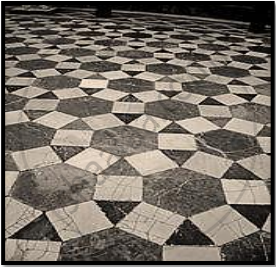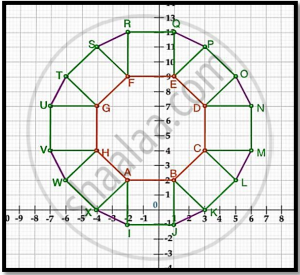Advertisements
Advertisements
प्रश्न
If (0, −3) and (0, 3) are the two vertices of an equilateral triangle, find the coordinates of its third vertex.
उत्तर
Let the given points be A(0, −3) and B(0, 3). Suppose the coordinates of the third vertex be C(x, y).
Now, ∆ABC is an equilateral triangle.
∴ AB = BC = CA
Squaring on both sides, we get \[36 = x^2 + \left( y - 3 \right)^2 = x^2 + \left( y + 3 \right)^2\]
\[x^2 + \left( y - 3 \right)^2 = x^2 + \left( y + 3 \right)^2 \]
\[ \Rightarrow y^2 - 6y + 9 = y^2 + 6y + 9\]
\[ \Rightarrow - 12y = 0\]
\[ \Rightarrow y = 0\]
Putting y = 0 in
\[x^2 + \left( 0 - 3 \right)^2 = 36\]
\[ \Rightarrow x^2 = 36 - 9 = 27\]
\[ \Rightarrow x = \pm \sqrt{27} = \pm 3\sqrt{3}\]
Thus, the coordinates of the third vertex are
APPEARS IN
संबंधित प्रश्न
Name the quadrilateral formed, if any, by the following points, and given reasons for your answers:
A(-3, 5) B(3, 1), C (0, 3), D(-1, -4)
In the seating arrangement of desks in a classroom three students Rohini, Sandhya and Bina are seated at A(3, 1), B(6, 4), and C(8, 6). Do you think they are seated in a line?
Find a point on y-axis which is equidistant from the points (5, -2) and (-3, 2).
Determine the ratio in which the straight line x - y - 2 = 0 divides the line segment
joining (3, -1) and (8, 9).
Prove that the points (4, 5) (7, 6), (6, 3) (3, 2) are the vertices of a parallelogram. Is it a rectangle.
In what ratio does the point (−4, 6) divide the line segment joining the points A(−6, 10) and B(3,−8)?
Show hat A(1,2), B(4,3),C(6,6) and D(3,5) are the vertices of a parallelogram. Show that ABCD is not rectangle.
Find the ratio in which the pint (-3, k) divide the join of A(-5, -4) and B(-2, 3),Also, find the value of k.
The base BC of an equilateral triangle ABC lies on y-axis. The coordinates of point C are (0, -3). The origin is the midpoint of the base. Find the coordinates of the points A and B. Also, find the coordinates of another point D such that ABCD is a rhombus.
Find the area of quadrilateral ABCD whose vertices are A(-3, -1), B(-2,-4) C(4,-1) and D(3,4)
The perpendicular distance of the point P (4, 3) from x-axis is
Find the ratio in which the line segment joining the points A(3, −3) and B(−2, 7) is divided by the x-axis. Also, find the coordinates of the point of division.
In \[∆\] ABC , the coordinates of vertex A are (0, - 1) and D (1,0) and E(0,10) respectively the mid-points of the sides AB and AC . If F is the mid-points of the side BC , find the area of \[∆\] DEF.
If R (x, y) is a point on the line segment joining the points P (a, b) and Q (b, a), then prove that x + y = a + b.
What is the distance between the points (5 sin 60°, 0) and (0, 5 sin 30°)?
what is the value of \[\frac{a^2}{bc} + \frac{b^2}{ca} + \frac{c^2}{ab}\] .
If the points A (1,2) , O (0,0) and C (a,b) are collinear , then find a : b.
If y-coordinate of a point is zero, then this point always lies ______.
Points (1, –1) and (–1, 1) lie in the same quadrant.
A tiling or tessellation of a flat surface is the covering of a plane using one or more geometric shapes, called tiles, with no overlaps and no gaps. Historically, tessellations were used in ancient Rome and in Islamic art. You may find tessellation patterns on floors, walls, paintings etc. Shown below is a tiled floor in the archaeological Museum of Seville, made using squares, triangles and hexagons.

A craftsman thought of making a floor pattern after being inspired by the above design. To ensure accuracy in his work, he made the pattern on the Cartesian plane. He used regular octagons, squares and triangles for his floor tessellation pattern

Use the above figure to answer the questions that follow:
- What is the length of the line segment joining points B and F?
- The centre ‘Z’ of the figure will be the point of intersection of the diagonals of quadrilateral WXOP. Then what are the coordinates of Z?
- What are the coordinates of the point on y-axis equidistant from A and G?
OR
What is the area of Trapezium AFGH?
